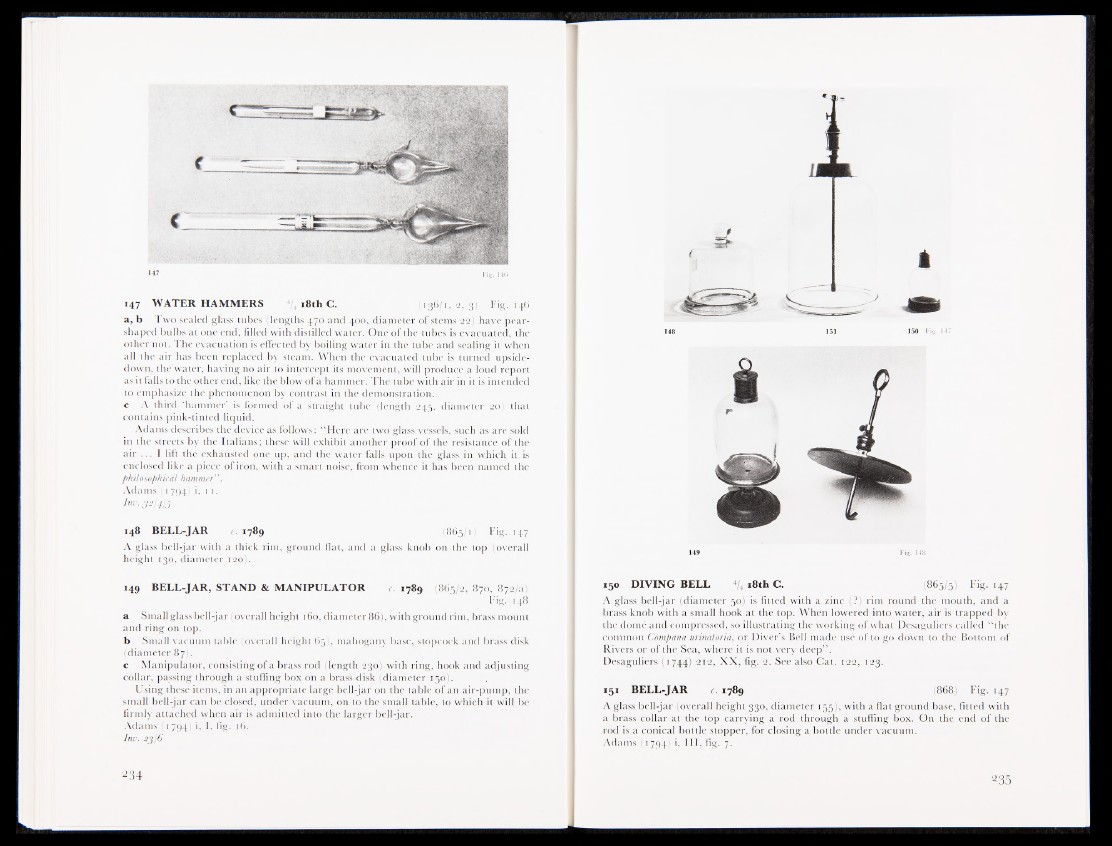
147 WATER HAMMERS +/+18th C. (136/1,2,3) Fig. 146
a, b Two sealed glass tubes (lengths 470 and 400, diameter of stems 22) have pear-
shaped bulbs at one end, filled with distilled water. One of the tubes is evacuated, the
other not. The evacuation is effected by boiling water in the tube and sealing it when
all the air has been replaced by steam. When the evacuated tube is turned upside-
down, the water, having no air to intercept its movement, will produce a loud report
as it falls to the other end, like the blow of a hammer. The tube with air in it is intended
to emphasize the phenomenon by contrast in the demonstration.
c A third 'hammer' is formed of a straight tube (length 245, diameter 20) that
contains pink-tinted liquid.
Adams describes the device as follows: “Here are two glass vessels, such as are sold
in the streets by the Italians; these will exhibit another proof of the resistance of the
air ... I lift the exhausted one up, and the water falls upon the glass in which it is
enclosed like a piece of iron, with a smart noise, from whence it has been named the
philosophical hammer” .
.Adams (1794 i, 1 1.
Inv. 32/4/3
148 BELL-JAR c. 1789 (865/1) Fig. 147
A glass bell-jar with a thick rim, ground flat, and a glass knob on the top (overall
height 130, diameter 120). 149 *
149 BELL-JAR, STAND & MANIPULATOR c. 1789 (865/2, 870, 872/a)
Fig. 148
a Small glass bell-jar (overall height 160, diameter 86), with ground rim, brass mount
and ring on top.
b Small vacuum table (overall height 65), mahogany base, stopcock and brass disk
(diameter 87).
c Manipulator, consisting of a brass rod (length 230) with ring, hook and adjusting
collar, passing through a stuffing box on a brass disk (diameter 150).
Using these items, in an appropriate large bell-jar on the table of an air-pump, the
small bell-jar can be closed, under vacuum, on to the small table, to which it will be
firmly attached when air is admitted into the larger bell-jar.
Adams (1794) i, I, fig. 16.
Inv. 23/6
150 DIVING BELL 4/4 18th C. (865/5) Fig. 147
A glass bell-jar (diameter 50) is fitted with a zinc (?) rim round the mouth, and a
brass knob with a small hook at the top. When lowered into water, air is trapped by
the dome and compressed, so illustrating the working of what Desaguliers called "the
common Compana urinatoria, or Diver’s Bell made use of to go down to the Bottom of
Rivers or of the Sea, where it is not very deep” .
Desaguliers (1744) 212, XX, fig. 2. See also Cat. 122, 123.
151 BELL-JAR c. 1789 (868) Fig. 147
A glass bell-jar (overall height 330, diameter 155), with a flat ground base, fitted with
a brass collar at the top carrying a rod through a stuffing box. On the end of the
rod is a conical bottle stopper, for closing a bottle under vacuum.
Adams (1794) i, III, fig. 7.